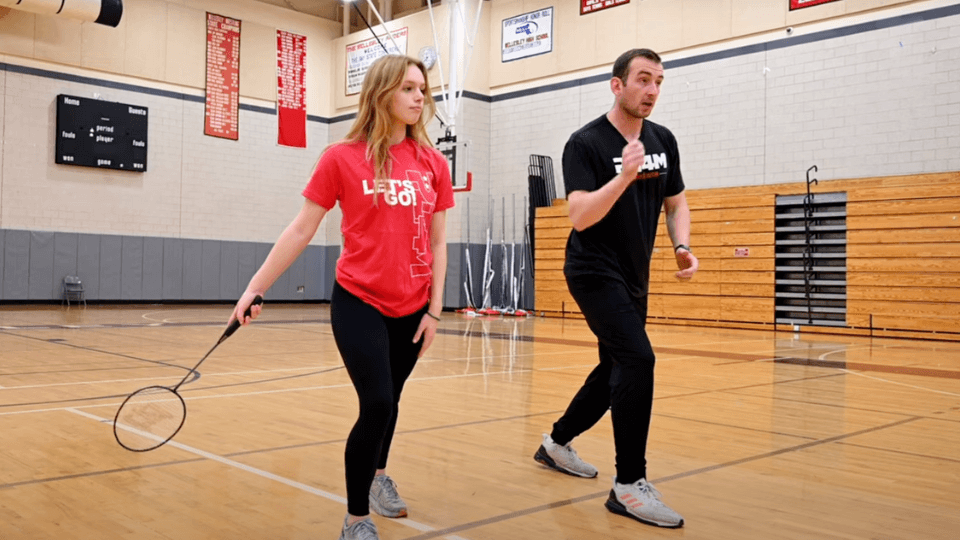Badminton is a popular sport that can be enjoyed by people of all ages and skill levels. We break down the essential components of badminton lesson plans that will help students move from basic skills to full game play. In addition, we provide 5 free instructional videos from PLT4M’s badminton lesson plans unit.
Importance of Badminton Lesson Plans
Badminton is a wonderful lifetime fitness activity. But much like any other physical activity, physical education presents an opportunity for skill development that will equip students with long-term success.
Rather than just pulling out the nets and telling students to play full-fledge badminton games right away, badminton lesson plans can introduce key concepts that will help them practice the different areas of the game.
If our goal in physical education is to build skills and confidence in a myriad of activities, we should take the same approach to our badminton unit. Like any activity in physical education, a badminton unit can offer students a chance to practice and develop key skills that will build confidence and comfort in the sport of badminton through PE lesson plans.
In a short amount of time, students of all skill levels can start to feel like confident badminton players and enjoy the game for many years to come.

High Level Goals of Badminton Lesson Plans
Before worrying about different types of advanced badminton shots like the net shot, drop shot, and kill shot, remember that badminton consists of some basic components that students should practice. The best badminton lesson plans allow students to get comfortable with the shuttle and racket. The basic elements of badminton lesson plans include an introduction to:
Forehand Grip
Backhand Grip
Forehand Shots (Underhand & Overhand)
Backhand Shots (Underhand & Overhand)
Rallying
Serve
Rules and Game Play (Singles and Doubles)
Our goal in many of these drills is developing muscle memory through repetition. Therefore, we want badminton lesson plans to focus on working as partners, not opponents. Encourage students to work together so that they can begin to learn the different types of swings and shots to be successful badminton lesson plans.
Added bonus! Teaching and introducing these basic elements of badminton makes your PE lessons shape standard aligned!
5 Badminton Drills For Physical Education Lesson Plans
Below you will find 5 badminton drills for physical education lesson plans. The full program from PLT4M comes fully loaded with more drills, technique tips, rules, and other components that help students become confident badminton players.
For all of our badminton drills for physical education, including the ones below, we recommend spending at least 10 minutes to first introduce the skill/drill and allowing students to break off and practice. Physical education teachers can mix and match drills and always return to previous drills to further improve students badminton skills.
Hitting To Yourself Drill
This drill has a variety of benefits that will help players get ready for the game of badminton. First, it helps new players learn the sweet spot of the racket. Next, it helps new players to track and watch the flight of the shuttle. Lastly, new players can get warmed up and get comfortable holding and moving around with a racket.
Drill Notes
For this drill, find an open space where you can safely move and hit your shuttle into the air.
1) Hold the racket in an underhand forehand grip.
2) Hit the shuttle directly in the air about 5-10 feet.
3) Track the shuttle as it flies up and comes back down so that you can hit again.
4) Repeat for anywhere from 2-10 hits in a row.
Overhand Forehand Swing
During many badminton rallies the shuttle is cleared above the net and players are in a position to hit the shuttle overhead. This is one of the most common shots we see and can practice rallying with an overhand strike.
The easier and more common shot is the overhand forehand. Work to get yourself in a position where you are lined up and ready to strike the shuttle.
Drill Notes
Partner 1: Thrower
1) Start with a shuttle in your throwing hand.
2) Bring your throwing hand overhead creating a 90-degree angle with your shuttle facing your target.
3) Step with your opposite foot as you extend your arm forwards.
4) Follow through and finish with your throwing hand pointing at your target.
5) Our goal is to throw the shuttle high enough that our partner can hit the shuttle overhead.
Partner 2: Hitter
1) Start by holding the racket with a forehand grip.
2) Turn into the sideways position with your body perpendicular to the net.
3) Bend your racket hand and raise it behind the head. The racket should be pointing down.
4) Raise your non-racket hand and point it towards the shuttle to help with timing and balance.
5) Straighten your elbow and rotate your forearm as you hit the shuttle, snapping your wrist to make contact with the shuttle. The goal is to hit the shuttle as high in the air as possible.
Practice 5-10 hits before switching roles. Eventually, this drill can be progressed to both players using rackets and practicing overhand forehand shots back and forth.
Overhand Backhand Swing
When a shuttle is high in the air but on your backhand side, the overhand backhand is your go to swing. This swing is most commonly used when you are not able to line up your shot in the forehand position, and on the non-dominant side of your body.
Partner 1: Thrower
1) Start with a shuttle in your throwing hand.
2) Bring your throwing hand overhead creating a 90-degree angle with your shuttle facing your target.
3) Step with your opposite foot as you extend your arm forwards.
4) Follow through and finish with your throwing hand pointing at your target.
5) Our goal is to throw the shuttle high enough that our partner can hit the shuttle overhead.
Partner 2: Hitter
1) Start by holding the racket with a backhand grip.
2) Lead with the same side foot you are holding the racket.
3) Bring your racket up with a high elbow.
4) Step through your swing and flick your wrist as you connect with the racket.
Practice 5-10 hits before switching roles. Eventually, this drill can be progressed to both players using rackets and practicing overhand forehand shots back and forth.
Underhand Forehand Swing
While we will receive many of our shots overhead, there will be plenty of times that because of a drop shot or our timing, we are forced to hit the shuttle underhand. In this drill we will have one partner throwing, one partner hitting the shuttle with an underhand forehand swing. The reason we start here is because the throw helps us to practice our swing without the racket.
Partner 1: Thrower
1) Step with the same foot you are throwing the shuttle with.
2) Draw your arm back and swing it forward so that the shuttle flies high into the air.
3) Follow through to finish your throw.
4) Work to throw the shuttle high so it clears net and lands in opposite court.
Partner 2: Hitter
1) Start by holding the racket with a forehand grip in the ready position.
2) Step with same foot as racket hand.
3) Draw your arm back and swing forward using your forearm to lead the swing.
4) Finish your swing by flicking your wrist to pop the shuttle into the air and over the net.
Practice 5-10 hits before switching roles. Eventually, this drill can be progressed to both players using rackets and practicing underhand forehand shots back and forth.
Underhand Backhand Swing
If the shuttle is on our non-dominant side and low, we will be forced to use the underhand backhand swing. The goal of this shot is to flick the shuttle from a lower position back up and over the net.
Drill Notes
Partner 1: Thrower
1) Step with the same foot you are throwing the shuttle with.
2) Draw your arm back and swing it forward so that the shuttle flies high into the air.
3) Follow through to finish your throw.
4) Work to throw the shuttle high so it clears net and lands in opposite court.
Partner 2: Hitter
1) Start by holding the racket with a forehand grip in the ready position.
2) Step with same foot as racket hand turning your body slightly away from the net.
3) Draw your arm back towards your body and swing forward using your forearm and elbow to lead the swing.
4) Flick your wrist to finish the shot and follow through to shoulder height and return to the ready position.
Practice 5-10 hits before switching roles. Eventually, this drill can be progressed to both players using rackets and practicing underhand backhand shots back and forth.
Bonus Content – Badminton Rules & Game Play Overview
Within all PLT4M game and activity units, we break down the rules and game play. Check out the quick overview video and written notes to get students rolling into a full game of badminton once they are ready! This is a crucial aspect of badminton lesson plans!
Rules & Game Play Description
1) Badminton games can be played as singles (1vs1) or doubles (2v2)
2) Games are played to 21 (win by 2)
3) Points are scored by either landing the shuttle in your opponent’s court or if your opponent fails to return the shuttle into your court (hits in the net or out of bounds).
4) Points are scored on all rallies (whether you are serving or receiving to start the rally)
5) A shuttle can only be hit once before return (no double hits or both partners hitting)
Service and Scoring Rules:
Serves must be in an underhand motion. Serve and scoring rules for singles and doubles listed below:
Singles
– At the beginning of the game (0-0) and when the server’s score is even, the server serves from the right service court. When the server’s score is odd, the server serves from the left service court.
– If the server wins a rally, the server scores a point and then serves again from the alternate service court.
– If the receiver wins a rally, the receiver scores a point and becomes the new server. They serve from the appropriate service court – left if their score is odd, and right if it is even.
Doubles
– A side has only one ‘set’.
– The service passes consecutively to the players as shown in the diagram.
– At the beginning of the game and when the score is even, the server serves from the right service court. When it is odd, the server serves from the left court.
– If the serving side wins a rally, the serving side scores a point and the same server serves again from the alternate service court.
– If the receiving side wins a rally, the receiving side scores a point. The receiving side becomes the new serving side.
– The players do not change their respective service courts until they win a point when their side is serving.
Key Takeaways On Badminton Lesson Plans
Badminton lesson plans help students work with partners to get the basic skills of the game down. From here, they are ready to start rallying and playing full games of badminton.
Badminton proves to be an excellent addition to physical education for a variety of reasons. First, badminton equipment is relatively affordable for most schools. Next, it develops great communication skills and learning to play with a partner or partners. Finally, it is a great lifetime physical activity that can get the heart rate up and focuses on skill development of hand-eye coordination and more.
As schools look to enhance physical education curriculum, badminton lesson plans can be a fantastic way to support students in the pursuit of lifetime physical activity, fitness, and wellness.
FAQs
Does PLT4M have other racket sports?
Yes! PLT4M also has PE lesson plans for popular games like pickleball! In addition, PLT4M is continuing to come out with other units and lesson plans. (Stay tuned for more!)
What other types of lesson plans and workouts does PLT4M have?
Consider PLT4M your full learning management system for health and physical education.
PLT4M has a full slate of PE lessons for physical education teachers to choose from! From PE games to fitness activities, PLT4M has countless options. Check out some of the most popular below:







